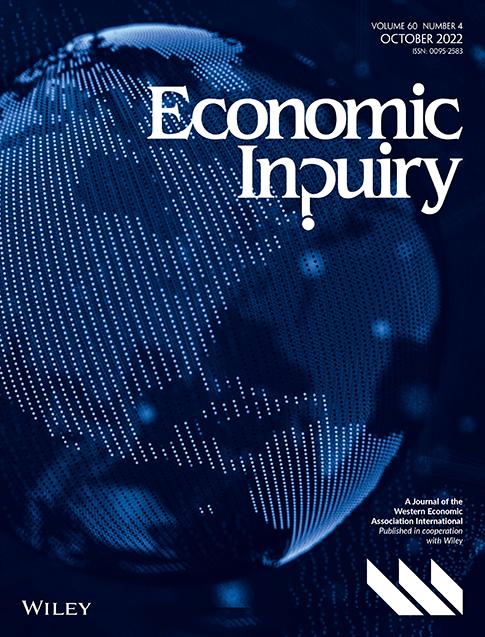Fiscal multipliers, expectations and learning in a macroeconomic agent-based model
Corresponding Author
Severin Reissl
RFF-CMCC European Institute on Economics and the Environment, Milan, Italy
Correspondence
Severin Reissl, RFF-CMCC European Institute on Economics and the Environment, Via Bergognone 34, 20144, Milan, Italy.
Email: [email protected]
Search for more papers by this authorCorresponding Author
Severin Reissl
RFF-CMCC European Institute on Economics and the Environment, Milan, Italy
Correspondence
Severin Reissl, RFF-CMCC European Institute on Economics and the Environment, Via Bergognone 34, 20144, Milan, Italy.
Email: [email protected]
Search for more papers by this authorManaging Editor: Cathy Zhang
Abstract
This paper evaluates the government expenditure multiplier and the influence of agents' expectations and consumption choices thereupon in a pre-existing estimated macroeconomic agent-based model. If the simple consumption heuristic of the baseline model is replaced by inter-temporal optimization subject to a budget constraint based on agents' estimations of future income, the multiplier becomes significantly smaller. When agents' beliefs about the effects of expenditure shocks are explicitly introduced, they can strongly increase or decrease the multiplier. If agents are allowed learn about the effects of government expenditure on their income from repeated shocks, they are able to correctly predict these effects.
Open Research
MODEL CODE
All files necessary to reproduce the simulations shown in this paper can be downloaded from https://github.com/SReissl/CATS2
Supporting Information
| Filename | Description |
|---|---|
| ecin13084-sup-0001_DisclosureForms.pdf148.6 KB | Supplementary Material 1 |
| ecin13084-sup-0002_Appendix.pdf490.9 KB | Supplementary Material 2 |
Please note: The publisher is not responsible for the content or functionality of any supporting information supplied by the authors. Any queries (other than missing content) should be directed to the corresponding author for the article.
REFERENCES
- Aiyagari, S. (1994) Uninsured idiosyncratic risk and aggregate saving. The Quarterly Journal of Economics, 109, 659–684. Available from: https://doi-org.ezproxyberklee.flo.org/10.2307/2118417
- Assenza, T., Cardaci, A., Delli Gatti, D. & Grazzini, J. (2018) Policy experiments in an agent-based model with credit networks. Economics: The Open-Access, Open-Assessment E-Journal, 12, 1–17. Available from: https://doi-org.ezproxyberklee.flo.org/10.5018/economics-ejournal.ja.2018-47
- Assenza, T., Colzani, P., Delli Gatti, D. & Grazzini, J. (2018) Does fiscal policy matter? Tax, transfer, and spend in a macro ABM with capital and credit. Industrial and Corporate Change, 27, 1069–1090. Available from: https://doi-org.ezproxyberklee.flo.org/10.1093/icc/dty017
- Assenza, T. & Delli Gatti, D. (2013) E Pluribus Unum: macroeconomic modelling for multi-agent economies. Journal of Economic Dynamics and Control, 37, 1659–1682. Available from: https://doi-org.ezproxyberklee.flo.org/10.1016/j.jedc.2013.04.010
- Assenza, T. & Delli Gatti, D. (2017) The financial transmission of shocks in a simple hybrid macroeconomic agent based model. Journal of Evolutionary Economics, 29, 265–297. Available from: https://doi-org.ezproxyberklee.flo.org/10.1007/s00191-018-0559-3
- Assenza, T., Delli Gatti, D. & Grazzini, J. (2015) Emergent dynamics of a macroeconomic agent based model with capital and credit. Journal of Economic Dynamics and Control, 50, 5–28. Available from: https://doi-org.ezproxyberklee.flo.org/10.1016/j.jedc.2014.07.001
- Auerbach, A. & Gorodnichenko, Y. (2012) Measuring the output responses to fiscal policy. American Economic Journal: Economic Policy, 4, 1–27. Available from: https://doi-org.ezproxyberklee.flo.org/10.1257/pol.4.2.1
- Banisch, S., Lima, R. & Araújo, T. (2012) Agent based models and opinion dynamics as Markov chains. Social Networks, 34, 549–561. Available from: https://doi-org.ezproxyberklee.flo.org/10.1016/j.socnet.2012.06.001
- Barro, R. (1981) Output effects of government purchases. Journal of Political Economy, 89, 1086–1121. Available from: https://doi-org.ezproxyberklee.flo.org/10.1086/261024
- Batini, N., Eyraud, L., Forni, L. & Weber, A. (2014) Fiscal multipliers: size, determinants, and use in macroeconomic projections. IMF Technical Notes and Manuals.
- Bouchaud, J.-P., Gualdi, S., Tarzia, M. & Zamponi, F. (2018) Optimal inflation target: insights from an agent-based model. Economics: The Open-Access, Open-Assessment E-Journal, 12, 20180015. Available from: https://doi-org.ezproxyberklee.flo.org/10.5018/economics-ejournal.ja.2018-15
- Bullard, J. & Mitra, K. (2002) Learning about monetary policy rules. Journal of Monetary Economics, 49, 1105–1129. Available from: https://doi-org.ezproxyberklee.flo.org/10.1016/S0304-3932(02)00144-7
- Caiani, A., Catullo, E. & Gallegati, M. (2018) The effects of fiscal targets in a monetary union: a multi-country agent-based stock flow consistent model. Industrial and Corporate Change, 27, 1123–1154. Available from: https://doi-org.ezproxyberklee.flo.org/10.1093/icc/dty016
- Caiani, A., Godin, A., Caverzasi, E., Gallegati, M., Kinsella, S. & Stiglitz, J. (2016) Agent based-stock flow consistent macroeconomics: towards a benchmark model. Journal of Economic Dynamics and Control, 69, 375–408. Available from: https://doi-org.ezproxyberklee.flo.org/10.1016/j.jedc.2016.06.001
- Catullo, E., Gallegati, M. & Russo, A. (2020) Forecasting in a complex environment: machine learning sales expectations in a Stock Flow Consistent Agent-Based simulation model. Universitat Jaume I Economics Department Working Paper, 2020/17.
- Dawid, H. & Day, R. (2007) On sustainable growth and collapse: optimal and adaptive paths. Journal of Economic Dynamics and Control, 31, 2374–2397. Available from: https://doi-org.ezproxyberklee.flo.org/10.1016/j.jedc.2006.05.014
- Dawid, H. & Delli Gatti, D. (2018) Agent-based macroeconomics. In: C. Hommes & B. LeBaron (Eds.) Handbook of Computational Economics, vol. 4. London: Elsevier/North-Holland, pp. 63–156.
10.1016/bs.hescom.2018.02.006 Google Scholar
- Dawid, H. & Fagiolo, G. (2008) Agent-based models for economic policy design: introduction to the special issue. Journal of Economic Behavior & Organization, 67, 351–354. Available from: https://doi-org.ezproxyberklee.flo.org/10.1016/j.jebo.2007.06.009
- Dawid, H., Gemkow, S., Harting, P., van der Hoog, S. & Neugart, M. (2018) Agent-based macroeconomic modeling and policy analysis: the Eurace@Unibi model. In: S. Chen, M. Kaboudan & Y. Du (Eds.) The Oxford Handbook of computational economics and finance. Oxford: Oxford University Press, pp. 490–519.
- Dawid, H., Harting, P. & Neugart, M. (2018a) Cohesion policy and inequality dynamics: insights from a heterogeneous agents macroeconomic model. Journal of Economic Behavior & Organization, 150, 220–255. Available from: https://doi-org.ezproxyberklee.flo.org/10.1016/j.jebo.2018.03.015
- Dawid, H., Harting, P. & Neugart, M. (2018b) Fiscal transfers and regional economic growth. Review of International Economics, 26, 651–671. Available from: https://doi-org.ezproxyberklee.flo.org/10.1111/roie.12317
- Day, R. (1999) Complex economic dynamics Vol. 2: an introduction to macroeconomic dynamics. Cambridge, MA: MIT Press.
- Del Negro, M., Eusepi, S., Giannoni, M., Sbordone, A., Tambalotti, A., Cocci, M. et al. (2013) The FRBNY DSGE model. Federal Reserve Bank of New York Staff Reports, 647.
- Del Negro, M., Giannoni, M. & Schorfheide, F. (2015) Inflation in the Great Recession and new Keynesian models. American Economic Journal: Macroeconomics, 7, 168–196. Available from: https://doi-org.ezproxyberklee.flo.org/10.1257/mac.20140097
- Delli Gatti, D. & Desiderio, S. (2015) Monetary policy experiments in an agent-based model with financial frictions. Journal of Economic Interaction and Coordination, 10, 265–286. Available from: https://doi-org.ezproxyberklee.flo.org/10.1007/s11403-014-0123-7
- Delli Gatti, D., Desiderio, S., Gaffeo, E., Cirillo, P. & Gallegati, M. (2011) Macroeconomics from the bottom up. Milano: Springer.
10.1007/978-88-470-1971-3 Google Scholar
- Delli Gatti, D. & Grazzini, J. (2020) Rising to the challenge: Bayesian estimation and forecasting techniques for macroeconomic agent-based models. Journal of Economic Behavior & Organization, 178, 875–902. Available from: https://doi-org.ezproxyberklee.flo.org/10.1016/j.jebo.2020.07.023
- Delli Gatti, D., Reissl, S. & Turco, E. (2021) V for vaccines and variants. CESifo Working Papers, 9291.
- Dilaver, O., Jump, R. & Levine, P. (2018) Agent-based macroeconomics and dynamic stochastic general equilibrium models: where do we go from here? Journal of Economic Surveys, 32, 1134–1159. Available from: https://doi-org.ezproxyberklee.flo.org/10.1111/joes.12249
- Dosi, G., Fagiolo, G., Napoletano, M. & Roventini, A. (2013) Income distribution, credit and fiscal policies in an agent-based Keynesian model. Journal of Economic Dynamics and Control, 37, 1598–1625. Available from: https://doi-org.ezproxyberklee.flo.org/10.1016/j.jedc.2012.11.008
- Dosi, G., Fagiolo, G., Napoletano, M., Roventini, A. & Treibich, T. (2015) Fiscal and monetary policies in complex evolving economies. Journal of Economic Dynamics and Control, 52, 166–189. Available from: https://doi-org.ezproxyberklee.flo.org/10.1016/j.jedc.2014.11.014
- Dosi, G., Fagiolo, G. & Roventini, A. (2010) Schumpeter meeting Keynes: a policy-friendly model of endogenous growth and business cycles. Journal of Economic Dynamics and Control, 34, 1748–1767. Available from: https://doi-org.ezproxyberklee.flo.org/10.1016/j.jedc.2010.06.018
- Dosi, G., Napoletano, M., Roventini, A., Stiglitz, J. & Treibich, T. (2020) Rational heuristics? Expectations and behaviors in evolving economies with heterogeneous interacting agents. Economic Inquiry, 58, 1487–1516. Available from: https://doi-org.ezproxyberklee.flo.org/10.1111/ecin.12897
- Dosi, G., Napoletano, M., Roventini A. & Treibich, T. (2016) The short- and long-run damages of fiscal Austerity: Keynes beyond Schumpeter. In: J. Stiglitz & M. Guzman (Eds.) Contemporary issues in macroeconomics – lessons from the crisis and beyond. Basingstoke: Palgrave Macmillan, pp. 79–100.
10.1057/9781137529589_9 Google Scholar
- Evans, G. & Honkapohja, S. (2001) Learning and expectations in macroeconomics. Princeton, NJ: Princeton University Press.
10.1515/9781400824267 Google Scholar
- Fagiolo, G. & Roventini, A. (2017) Macroeconomic policy in DSGE and agent-based models redux: new developments and challenges ahead. The Journal of Artificial Societies and Social Simulation, 20. Available from: https://doi-org.ezproxyberklee.flo.org/10.18564/jasss.3280
- Fernández-Villaverde, J. & Rubio-Ramírez, J. (2005) Estimating dynamic equilibrium economies: linear versus nonlinear likelihood. Journal of Applied Econometrics, 20, 891–910. Available from: https://doi-org.ezproxyberklee.flo.org/10.1002/jae.814
- Franke, R. & Westerhoff, F. (2017) Taking stock: a rigorous modelling of animal spirits in macroeconomics. Journal of Economic Surveys, 31, 1152–1182. Available from: https://doi-org.ezproxyberklee.flo.org/10.1111/joes.12219
- Galí, J., López-Salido, J.D. & Vallés, J. (2007) Understanding the effects of government spending on consumption. Journal of the European Economic Association, 5, 227–270. Available from: https://doi-org.ezproxyberklee.flo.org/10.1162/JEEA.2007.5.1.227
- Gechert, S. & Will, H. (2012) Fiscal multipliers: a meta regression analysis. IMK Working Paper, 97.
- Gigerenzer, G. (2008) Rationality for mortals – how people cope with uncertainty. Oxford: Oxford University Press.
- Gobbi, A. & Grazzini, J. (2019) A basic New Keynesian DSGE model with dispersed information: an agent-based approach. Journal of Economic Behavior & Organization, 157, 101–116. Available from: https://doi-org.ezproxyberklee.flo.org/10.1016/j.jebo.2017.12.015
- Hall, R. (2009) By how much does GDP rise if the government buys more output? Brookings Papers on Economic Activity, 2, 183–249.
- Harting, P. (2015) Stabilization policies and long term growth: policy implications from an agent-based macroeconomic model. Bielefeld Working Papers in Economics and Management, 06-2015.
- Izquierdo, L., Izquierdo, S., Galán, J. & Santos, J. (2009) Techniques to understand computer simulations: Markov chain analysis. The Journal of Artificial Societies and Social Simulation, 12, 6. https://www.jasss.org/12/1/6.html
- Kirman, A. (1992) Whom or what does the representative individual represent? The Journal of Economic Perspectives, 6, 117–136. Available from: https://doi-org.ezproxyberklee.flo.org/10.1257/jep.6.2.117
- Mitra, K., Evans, G. & Honkapohja, S. (2019) Fiscal policy multipliers in an RBC model with learning. Macroeconomic Dynamics, 23, 240–283. Available from: https://doi-org.ezproxyberklee.flo.org/10.1017/S1365100516001176
- Napoletano, M., Roventini, A. & Gaffard, J. (2017) Time-varying fiscal multipliers in an agent-based model with credit rationing. Kiel Institute for the World Economy Economics Discussion Paper, 2017-112.
- Poledna, S., Miess, M. & Hommes, C. (2020) Economic forecasting with an agent-based model. IIASA Working Papers, 20-001.
- Ramey, V. (2011a) Can government purchases stimulate the economy? Journal of Economic Literature, 49, 673–685. Available from: https://doi-org.ezproxyberklee.flo.org/10.1257/jel.49.3.673
- Ramey, V. (2011b) Identifying government spending shocks: it’s all in the timing. The Quarterly Journal of Economics, 126, 1–50. Available from: https://doi-org.ezproxyberklee.flo.org/10.1093/qje/qjq008
- Reissl, S. (2021) Heterogeneous expectations, forecasting behaviour and policy experiments in a hybrid Agent-based Stock-flow-consistent model. Journal of Evolutionary Economics, 31, 251–299. Available from: https://doi-org.ezproxyberklee.flo.org/10.1007/s00191-020-00683-7
- Riccetti, L., Russo, A. & Gallegati, M. (2013) Unemployment benefits and financial leverage in an agent based macroeconomic model. Economics: The Open-Access, Open-Assessment E-Journal, 7, 20130042. Available from: https://doi-org.ezproxyberklee.flo.org/10.5018/economics-ejournal.ja.2013-42
- Riccetti, L., Russo, A. & Gallegati, M. (2015) An agent based decentralized matching macroeconomic model. Journal of Economic Interaction and Coordination, 10, 305–332. Available from: https://doi-org.ezproxyberklee.flo.org/10.1007/s11403-014-0130-8
- Ruppert, D., Wand, M. & Carroll, R. (2003) Semiparametric regression. Cambridge: Cambridge University Press.
10.1017/CBO9780511755453 Google Scholar
- Russo, A., Catalano, M., Gaffeo, E., Gallegati, M. & Napoletano, M. (2007) Industrial dynamics, fiscal policy and R&D: evidence from a computational experiment. Journal of Economic Behavior & Organization, 64, 426–447. Available from: https://doi-org.ezproxyberklee.flo.org/10.1016/j.jebo.2006.06.016
- Salle, I. (2015) Modeling expectations in agent-based models – an application to central bank’s communication and monetary policy. Economic Modelling, 46, 130–141. Available from: https://doi-org.ezproxyberklee.flo.org/10.1016/j.econmod.2014.12.040
- Sargent, T. (1993) Bounded rationality in macroeconomics. Oxford: Oxford University Press.
10.1093/oso/9780198288640.001.0001 Google Scholar
- Simon, H. (1982) Models of bounded rationality. Cambridge, MA: MIT Press.
- Smets, F. & Wouters, R. (2007) Shocks and frictions in US business cycles: a Bayesian DSGE approach. The American Economic Review, 97, 586–606. Available from: https://doi-org.ezproxyberklee.flo.org/10.1257/aer.97.3.586
- Teglio, A., Mazzocchetti, A., Ponta, L., Raberto, M. & Cincotti, S. (2019) Budgetary rigour with stimulus in lean times: policy advices from an agent-based model. Journal of Economic Behavior & Organization, 157, 59–83. Available from: https://doi-org.ezproxyberklee.flo.org/10.1016/j.jebo.2017.09.016
- Wood, S. (2017) Generalized additive models – an introduction with R. Boca Raton, FL: CRC Press.
10.1201/9781315370279 Google Scholar




